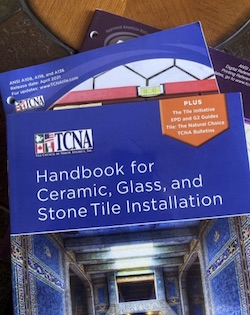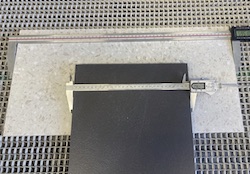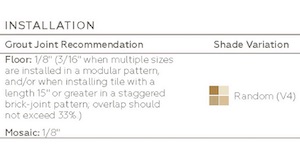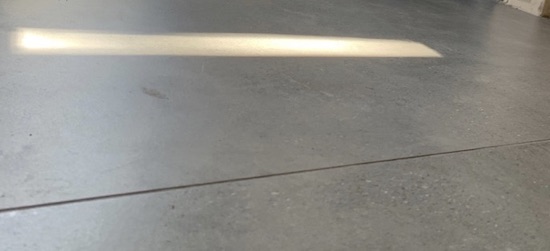“We want the smallest grout joint possible!”
Whether you are a residential or commercial contractor, this request is commonly made. Of course the response your client wants to hear is something like a credit card width – or even no grout joint. Or maybe you have a client that is actually demanding these small grout joints.
If you have been a reader of TileLetter over the years, it should be evident that one of the main themes is education and knowledge, and what those two items can bring to the table when you’re in those discussions. I have found if I keep “my opinion” out of the discussion, it is less confrontational for those clients who may want to disagree. So, in this article I will try to present a general overview of how to respond to that request by referring to the standards. And for those who like to get in the weeds of the discussion – or as my wife would say for all us tile nerds – I can do that as well.
Talking about standards


So, I suggested referencing the standards, and the standards I will be referring to are those from the Tile Council of North America (TCNA) and American National Standard Specifications (ANSI).
We are going to be referring to two sections of ANSI. ANSI A108 is an installation standard; and ANSI A137 is a standard for manufacturing ceramic tile.1 Perhaps you don’t have a copy of the ANSI manual, but hopefully everyone reading this article has a TCNA Handbook. Some excerpts are reprinted from ANSI in the TCNA Handbook. One of the many benefits of joining NTCA is that you automatically get a brand new TCNA Handbook every year. The Handbook is absolutely essential for all tile contractors.
On page 38 of the 2021 TCNA Handbook, in the chapter titled Grout Joint Size, Layouts and Patterns, is an excerpt from ANSI A108.02-2019, Section 4.3.8 Grout joint size. It states:
The actual grout joints size shall be at least three times the actual variation of the facial dimensions of the tile supplied.2
Basically, the standard is noting that every tile in the box is not the exact size. When a manufacturer produces a tile, and they claim it meets the ANSI specifications, there is a maximum range of size (facial dimensions) the tiles must be within. The range is different for a calibrated tile (a tile that has been sorted to meet a certain manufacturer’s stated range) as opposed to a rectified tile (a tile that has its edges mechanically finished to achieve a more precise facial dimension). Simply put, whether it is a calibrated tile or a rectified tile, when you purchase a tile that complies with ANSI, the manufacturer is noting that these tiles fall within a certain range. This range is defined in the ANSI A137.1 specifications.
Calculating grout joints
Since rectified porcelain is the most popular, let us specifically discuss and use as an example a rectified porcelain. Referring to Table 10 in ANSI A137.1, for rectified porcelain, the minimum and maximum caliber range (variation from average facial dimensions of sample tested) is:
Minimum: -0.25% or -.03
(whichever is less)
Maximum: +0.25% or +.03
(whichever is less)
Let’s calculate this in a real-world example using a 16″x20″ rectified porcelain tile. Using the longest 20″ side, the minimum variation calculation (in other words, how much shorter can another piece of tile be in the same caliber listed on the box label) is as follows:
-.0025 x 20″ = -.05″.
Since -.03″ is less than -.05″,
use -.03″
A similar calculation to find the maximum variation (how much longer can another piece of tile be in the same caliber on the box label):
.0025 x 20″ = .05″.
Since .03″ is less than .05″,
use .03″
Therefore, from the sample tested (sample tested is the target size), the total variation in caliber ranges from -.03″ to +.03″. The total size variation range (a range from the shortest tile to the longest tile) is .03″+.03″=.06″.
Now that we know the variation of facial dimension, we can refer back to the ANSI A108.02-2019, Section 4.3.8 language. The minimum grout joint size is three times the total facial variation. Therefore, the minimum grout joint size can be calculated as follows: .06″x3=.18″, approximately 3/16″.
Wow, a minimum joint of 3/16″! Then how are tiles being installed with smaller joints such as 1/8″? This is because if a tile is manufactured to the ANSI standard, it simply is complying to the minimum as noted in the standard. That does not mean that the tile manufacturer cannot produce a tile with greater tolerances, and typically that is usually the case. Some manufacturers publish their tolerances, but unfortunately many do not.


It is possible, but typically not feasible, to take a micrometer and measure the lengths of tiles to get an idea of their variation. Micrometers are expensive to purchase and are especially expensive when trying to measure tiles greater than 24″. Therefore, many times we simply have to rely on the manufacturer’s product data sheets that either state the maximum and minimum facial dimension or – more often – they will state the minimum grout joint recommended.
Skinny grout joints
You may be thinking, “What degree of tolerances must a tile be manufactured to in order to achieve a 1/8″ (.125″) grout joint?” So let’s work these calculations backwards.
We must divide 1/8″ (.125″) by 3 to find the maximum allowable facial dimension (.125/3 = .042″). Going back to our example of a 16″ x 20″ tile, we must divide by 2 to find the minimum and maximum range of how much longer and shorter a tile can be from the manufacturer’s sample.
.042″ / 2 = .021″


Therefore, the minimum and maximum caliber range (variation from average facial dimension of sample) is -.021 and +.021 (for those who prefer metric, .53mm). Those are very tight tolerances, but achievable in modern manufacturing facilities.
Installing tiles with smaller grout joints than recommended can put your installation in jeopardy, especially if you start your layout with a tile on the small end of the caliber range. Understanding the tolerances the tile is manufactured to will keep you and your company from the exposure of a failed layout and assists in educating your client in a way that reduces possible contention.
1 The TCNA Handbook and ANSI manuals are all available for purchase in the online store on the NTCA website: tile-assn.com.
2 Please note, for this discussion we will not be considering the grout joint size for running bond/brick joint patterns; that is a topic for another day.







